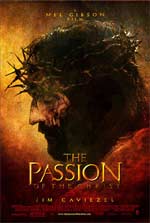

 - for sequences of graphic violence.
- for sequences of graphic violence.
The Passion Of The Christ follows the last twelve hours of Jesus's life from his emotional turmoil in the Garden of Gethsemane till his final moments of the crucifixion. Actor Mel Gibson brings the struggle and sacrifice of Jesus (Jim Caviezel) to life like nothing ever seen before.
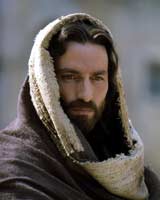
People who know me know I have a strict personal rule against seeing R-rated films. I've grown up and have
researched enough films to realize most if not all R-rated movies are not edifying for believers and
just shouldn't be endorsed by Christians. When I learned of actor Mel Gibson's new project that was to depict
the last twelve hours of Jesus's life in harsh, brutal, graphic realism, I knew I may have to break my own
code. And while many might argue that a rating is just a rating (as many newer PG-13 films can be just as bad
or worse than some R films), the fact is that an R-rated film usually is R for good reason. And it's usually
a good enough reason to ensure it shouldn't be viewed by younger audiences, not to mention Christians of all ages.
With that, Gibson's The Passion Of The Christ is rated R for a very, very good reason -- it's brutally
violent and graphic. (**This review contains some spoilers regarding content details**)
The Passion Of The Christ wastes no time getting started by opening in the Garden of Gethsemane where Jesus is painfully praying for the sacrifice He know He is about to make. With Jesus face-down on the ground in agony, sweating blood as His disciples sleep beside a nearby tree, Gibson paints a vivid picture of Christ's pain and suffering from the beginning. And that's essentially the message Gibson is trying to get across to his audience -- Christ's immense sacrifice. By taking his time to devote an entire film to the last hours of the Son of God's time on Earth in great detail, Gibson is able to bring to life the Gospels in a way we've never seen before. Gibson wanted the brutality of what Jesus actually lived out when being tortured to be true and real. He wanted viewers to know the price Jesus paid. And he wanted us to realize through all the brutality, that Jesus went willingly. Never once did Jesus go kicking and screaming. Jesus laid His life down as a living sacrifice to pay for our transgressions -- for things man has done and will do till the end of time. Most of the earlier theatrical versions of the crucifixion are virtually glamorous in comparison to what we see here. In truth, Jesus was beaten beyond recognition. And while Jesus was probably actually more disfigured in real life than He was in The Passion, no believer has seen Christ's torture done this accurate before.
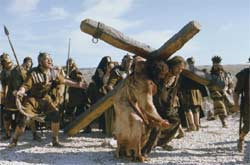
How violent IS The Passion Of The Christ? It's extreme in every sense of the word. While I am no
fan of graphic violence, I must admit that after reading all I did about the film before seeing it, I actually
expected worse than what I saw. Regardless, the audience is still given a front row seat to the vicious and relentless
flogging of Jesus. We see nearly every stoke of the rods bruising and lashing his back. Actor James Caviezel
does an incredible job realistically expressing Jesus's agony. The Son of God was given the beating of a lifetime
and this actually happened. It was harrowing to watch the Roman soldiers maliciously mock Jesus, laughing almost
non-stop at His expense. Thankfully Gibson utilized brief flashback scenes wonderfully and shots of Jesus's mother
Mary and her reactions to break up the constant beating Jesus took. Following the whipping of Jesus, we then
see Him mercilessly struck blow after blow by a barbed whip (something like that of a cat o' nine tails),
and watch as it tears his skin from his back leaving raw, bloody gashes all over his body. After several lashes, the hooks
on the whip catch onto his side and tear pieces of his flesh from his body as the Roman soldier yanks it back.
And as if that weren't enough, the soldiers have him lay on his back to allow his chest, stomach, and legs
to be flogged as well. Thankfully Gibson spares us from each and every stroke hitting His body being seen,
but we do often hear the fleshy impacts and the splattering as Jesus's blood is spread everywhere.
And keep in mind, this is all before He must carry His cross to Golgotha where He is barbarically nailed to
the cross.
Mel Gibson stays true to the Gospels quite well, but still takes the liberty of inventing believable back story to aid the plot along. Through some side plots (involving Pontius Pilate and his wife as well as Mother Mary and Mary Magdalene) and wonderfully-incorporated flashback moments to scenes in Jesus's life, Gibson incorporates moments from the Last Supper, Sermon on the Mount, and when He washed the disciples' feet. These moments not only broke up the brutality of the film and gave the audience a break from the harsh beatings, but it also helped paint a portrait of Jesus as we know Him. My favorite scene involved one Gibson invented for the story that showed Jesus working on building a table while He lived with his mother and the way the two of them interacted (which included Him joking with her). It reminded us that Jesus was not only God but also God in human form. I wanted to really get to know that Jesus because He was so tangible and real. Another highlighted moment featured Mary watching Jesus carrying His cross to Golgotha and falling under the weight of it. She then recalled a moment of Jesus as a tiny child falling and her being there to pick Him up and hold and comfort Him. With that, she runs to her now grown up and battered son, in her attempt to help Him one last time. Gibson put so much feeling and emotion into his characters that it made me wish he'd spent longer on the Jesus His mother knew and raised -- before He is given His death sentence.
Gibson also works the presence and hand of evil into the story very well. A creepy Satan character cloaked in black lurks in the crowds from scene to scene, glaring menacingly at Jesus who knows how to resist and defeat his adversary. The torment Satan puts Judas through following his betrayal of Jesus is also a unique and disturbing encounter. Satan uses what look like little children to mock and prod at Judas, with their cute faces suddenly morphing into demonic creatures. And in another scene, we see Satan cradling what looks to be a demonic looking child in what almost appears to be a mockery of the connection between Mary and her Son. Gibson handles these references artistically and symbolically, while teetering on the edge of bizarre but never crossing it too far.
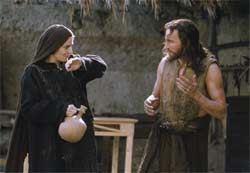
In The Passion Of The Christ, actor James Caviezel steps in as the latest actor to portray our Savior on the big screen. There isn't a single actor I could think of today who could portray Christ better than Caviezel. From first seeing him in the fantastic drama Frequency to his take on the complex main character from The Count Of Monte Cristo, Caviezel has proven to be an intense actor who can do extraordinary things with a role. And with the kind of physical demands this specific portrayal of Jesus demands, Caviezel excels. With that said, all of the other cast did a fantastic job presenting real and believable characters who conveyed so much feeling and emotion without, at times, even having to utter a word.
As many sources have reported early on, the film focuses nearly exclusively on the death of Jesus, only momentarily touching on the resurrection in the final shots. What bothered me is I really wanted to see more. I know the immense victory Jesus claimed when He rose from the dead, and I wanted to celebrate that. I wanted to share in the disciples' and Mary's joy to see their Teacher and Son alive again. Also, some of the flashbacks were so brief they were merely a tease. While they were effective as they were the way they were, at times they left me just wanting more details and interaction with his family and followers. With that noted, Gibson also tells the story from the viewpoint that the audience already has a pretty good understanding of scripture and the background stories. While some scenes might be self-explanatory, many don't explain to the audience straight-out who certain characters are, why they're there, or what they may have done before the events in this film. This may only serve as a hindrance to those who have no prior knowledge of scripture.
The Passion Of The Christ is no fluff entertainment. I wanted to just stay seated after the film ended. I didn't know what to do with myself. I'd just witnessed the execution of my King on screen. I'd just witnessed what my sin did to love personified. What do you do after seeing that? What do you say? Regardless, this film is just way too heavy and way too violent for the younger crowd and, Parents, I highly recommend seeing this film before letting any of your teens see it if you're concerned. This is not likely to be a film easily forgotten once the credits roll. This movie hits and it'll knock the wind out of you.
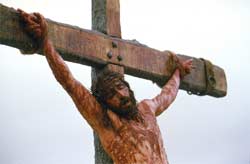
The music of The Passion is brilliantly composed by John Debney who has recently done films like Welcome To Mooseport and, ironically, Bruce Almighty. For a composer who pulls off light-hearted comedy theatrical scores so well, it's all the more impressive that Debney can do as solid a job as he did here on The Passion Of The Christ. The music is often beautiful and doesn't take away from the scenes. However, there were a few moments where the coupling of the beautiful, booming theatrical score and the slow motion camera effects hindered the realism of some scenes. But for the most part it merely enhanced them. In a similar fashion, the usage of the original Hebrew and Latin languages (with English subtitles) added so much to the authentic feel of the film.
And finally, if I hear that this film is anti-Semitic one more time, I'm going to go scream till a vein pops. The film is no more anti-Jewish than God's Word is. And God's Word is NOT. So to all the protesters, put your picket signs down and go SEE the movie for yourself -- and bring an open mind. The truth of the matter is, that Christians don't care if it was the Jewish leaders and mob that called for Jesus to be put to death or the Romans who carried out the final sentence. WE ALL killed Christ. Jesus willingly laid His life down as a sacrifice and the film even has Him saying that to His disciples. God chose for it to happen this way. Mel is not pointing fingers at anyone but himself for the death of Jesus. We're all responsible because of our sins. The film is no more anti-Jewish than it is anti-Italian.
The Passion Of The Christ is rated R for good reason. There's no hiding the gruesome blows Jesus took or the scars on his body or the blood that dripped off his skin. This is not a film for the squeamish and certainly not a family movie. This isn't entertainment. The Passion is an "experience" much like many are describing it. I applaud Mel Gibson and Caviezel for their work on this. I can only hope the two will pair again for perhaps greater elaboration of Jesus's life before the events depicted in The Passion. - John DiBiase (reviewed: 2/26/04)
Disclaimer: All reviews are based solely on the opinions of the reviewer. Most reviews are rated on how the reviewer enjoyed the film overall, not exclusively on content. However, if the content really affects the reviewer's opinion and experience of the film, it will definitely affect the reviewer's overall rating.
 John Schlitt Releases Limited Vinyl Edition of "The Christmas Project" John Schlitt Releases Limited Vinyl Edition of "The Christmas Project"Tue, 23 Dec 2025 18:00:00 EST |
 Elan Brio Shares His Passion, 'Written In Sound,' Alongside Nikkuubeats Elan Brio Shares His Passion, 'Written In Sound,' Alongside NikkuubeatsMon, 22 Dec 2025 14:20:00 EST |
 m1L and R.kitect Announce New EP and Lead Single m1L and R.kitect Announce New EP and Lead SingleMon, 22 Dec 2025 14:05:00 EST |
 "David," Starring Phil Wickham, Earns Highest-Grossing Faith-Based Animated Theatrical Opening of All Time "David," Starring Phil Wickham, Earns Highest-Grossing Faith-Based Animated Theatrical Opening of All TimeSun, 21 Dec 2025 16:05:00 EST |
 Phil Wickham Breaks Mediabase Record with No. 1 Song Phil Wickham Breaks Mediabase Record with No. 1 SongFri, 19 Dec 2025 18:10:00 EST |
 B. Cooper Releases New Single, "Back," ft. 350 B. Cooper Releases New Single, "Back," ft. 350Fri, 19 Dec 2025 17:25:00 EST |
 The Undertaking! Releases "Only Left Alive To See The End" on CD The Undertaking! Releases "Only Left Alive To See The End" on CDFri, 19 Dec 2025 17:15:00 EST |
 Click here All News Headlines |
Click here All News Headlines |